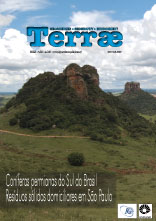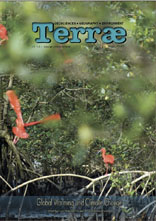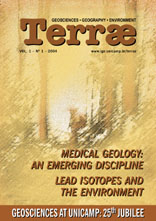Save the date / Call for papers
A revista Terræ publica simultaneamente as edições online de 2016 e 2017. As edições impressas acham-se temporariamente suspensas, pois os editores reconhecem que a internet oferece formas mais eficazes para disseminar rapidamente os resultados das pesquisas. As reformulações do periódico objetivam ampliar a abrangência, combinando redução de custos com rapidez de publicação. Cada vez mais a revista consolida a tendência de cobrir temas multidisciplinares que revelem formas de interação das Geociências com as diferentes áreas do conhecimento humano. A edição de Terræ 2017 é inteiramente dedicada ao tema GEOPARQUES.
A revista aceita trabalhos e comunicações em Português, Inglês e Espanhol.
Chamada de trabalhos / CALL FOR PAPERS
Uma vez recuperado o tempo de ausência na web, a edição de Terræ 2018 tornar-se-á uma boa opção para publicação de artigos científicos. O volume deverá reunir contribuições referentes a GEOÉTICA, tema que permite acomodar abordagens diferenciadas que revelem as inter-relações entre a sociedade e os ecossistemas terrestres.
O sistema de submissão e avaliação de artigos científicos está em pleno funcionamento, sendo feito exclusivamente pelo E-mail: terrae@ige.unicamp.br. Nosso sítio web está à sua disposição.
Esperamos sua visita e participação!
Os editores.
10/01/2018- 16:31 pm
Chamada de trabalhos/ Call for papers para o Volume 15, 2018
Novas contribuições são aceitas para o volume 2018 de Terræ.
Data limite 30.abril.2018
10/01/2018- 16:31 pm
Chamada de trabalhos/ Call for papers para os eventos:
VIII GeoSciEd 2018 – the 8th Quadrennial Conference of the
International Geoscience Education Organisation (IGEO)
– Geosciences for Everyone –
VIII Simpósio Nacional de Ensino e História de
Ciências da Terra / EnsinoGEO-2018
– Geociências para Todos –
Campinas – Sao Paulo – Brazil, July 2018
Acesse o site: http://www.ige.unicamp.br/geoscied2018/en/.
Data limite 11.fevereiro.2018
11/01/2018- 13:40 pm
Livro "Geologia do Brasil”, 2012: Reserve já seu exemplar, sem despesas de remessa.
Visite o endereço eletrônico: www.editorabeca.com.br
Os editores
Campinas, janeiro de 2018.
Holocene Pb isotope evolution: the record of the anthropogenic activity in the last 6,000 years
Atani H. de Paula
Faculty of Geology
State University of Rio de Janeiro – UERJ
Mauro C. Geraldes
Faculty of Geology
State University of Rio de Janeiro – UERJ
geraldes@uerj.br
ABSTRACT
The objetive of this contribution is to build a Pb isotope standard curve during the last 6,000 years based on reported data worldwide. The history of Pb isotope signature has been investigated by analyzing the isotope composition of Pb in suspended particulate matter (aerosols), sediments, water, ice and soil. The 206Pb/207Pb natural background values are about 1.199 between 12,000 and 2,600 years, as observed in sediments (Europe and North America) and ice caps (Europe and Antactica). The depression of the 206Pb/207Pb values at about 2,500 years (1.176 to 1.184) may be explained due to an intensive mining activity during the time of the Roman Empire. During the Medieval period (1,700-1,200 years ago) 206Pb/207Pb values increased whereas, at the same time, the worldwide Pb production decreased after the fall of Rome, and the values of 206Pb/207Pb recorded in sediments are about 1.176.The Pb isotope curves in sediments and ice caps for the industrial revolution period recorded in Europe, North America and Antarctica present different patterns. In general way, the Pb isotope curve for the last 200 years records the initial period of industrialization, when coal was the main source of energy (206Pb/207Pb values about 1.125), followed by the Pb-enriched gasoline (206Pb/207Pb values about -1.190-1.195), and as last period, occurred after the fall in the use of gasoline Pb additives (206Pb/207Pb values about 1.240)
A PDF reader is required to view the article files. Make the download here: Adobe Acrobat or Foxi















